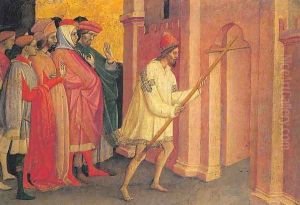Michele di Matteo Lambertini Paintings
Michele di Matteo Lambertini was an Italian painter primarily active during the early to mid-15th century. Not much is known about his personal life, including the exact dates of his birth and death. His work flourished in the period known for the early Renaissance, and he was a contemporary of other significant artists who were beginning to experiment with the innovations that would come to define the Renaissance style.
Lambertini worked primarily in Bologna and is known to have been active from 1416 until around 1469. His style shows a blend of late Gothic and early Renaissance elements, which was typical of many artists working in Italy at the time who were transitioning between the two styles. Michele di Matteo Lambertini's contributions to art were rooted in the traditions of the Trecento, yet, his work also showed an appreciation for the emerging Renaissance principles of perspective and volume.
Although specific details of his life are sparse, his artistic legacy is evident in several signed and documented works that have been attributed to him. These works illustrate his skill and the evolution of his style over time. One of his most notable works is the 'Annunciation' altarpiece, which displays a clear narrative style and attention to detail typical of the era. Other works attributed to him include frescoes and paintings of religious subjects, which were common commissions during that period for churches and private devotional spaces.
Michele di Matteo's works are characterized by their delicate linearity, use of color, and attention to detail. His figures often have a characteristic sweetness and grace, which were elements appreciated in the devotional paintings of the time. Despite not being as widely recognized as some of his contemporaries, Michele di Matteo Lambertini contributed to the artistic developments of his time and his works still offer valuable insights into the transitional period between Gothic and Renaissance art in Italy.
The lack of extensive records on Michele di Matteo Lambertini's life and the uncertain date of his death mean that his biography is pieced together from the artworks he left behind and the historical context in which he created them. His legacy is preserved through the art he produced, which continues to be studied and appreciated for its place in the history of Italian Renaissance art.
